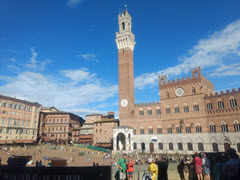
We had tried to visit Siena on our last visit in 2015, but it was too complicated. On this visit we made it a priority, and I am so glad we did! We had many foodie discoveries and discoveries of a purely sublime "you'll never see this again" tourist nature, but it also answered a deep foodie question that I desperately wanted to get to the bottom of.
All of the many marvels notwithstanding, for Siena my foodie high point was the nonpareil dinner at Tar-Tufo, where I finally sampled an authentic, local, expensive Bistecca alla Fiorentina. But let's get to Siena and explore those other marvels first. If you ever expect to rent a car in Italy, this is where you can benefit from my experience.
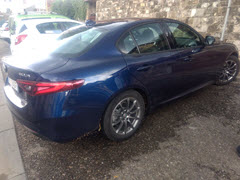
On Monday, 25 June we started in Florence. I had reserved a "Buick Opel or similar" through Europcar in January. Then in May some well-meaning website offered some advice that appeared to be valuable, but which actually resulted in losing the Opel reservation with nothing to replace it due to confusion with the Europcar way of doing things. Now my original reservation was lost, and cars were selling out fast everywhere, and prices were going up. I ended up reserving a similar car (automatic transmission, big enough for 3 plus bags) through RentalCar.com, with added insurance through RentalCover.com. RentalCar.com had given me one of those unavailable cars, this one from Hertz. Of course, that's why they were becoming unavailable to regular guys like me.
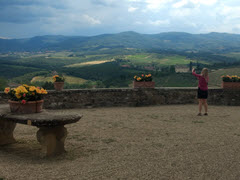 I arrived at the Hertz office 10 minutes before opening, and was lucky to draw number 13 from the deli-counter number ticket system. By the time I was called, they no longer had a car of the class that I had reserved, so they gave me a $40,000 Alfa Romeo Giulia, pictured here. Sometimes it's better to be lucky than good!
I arrived at the Hertz office 10 minutes before opening, and was lucky to draw number 13 from the deli-counter number ticket system. By the time I was called, they no longer had a car of the class that I had reserved, so they gave me a $40,000 Alfa Romeo Giulia, pictured here. Sometimes it's better to be lucky than good!
The car rental was about $500 + a $214 one-way fee to deliver the car in Palermo. The insurance was another $100 or so, and it saved us an $800 repair, and all the related delays. I recommend both services on that limited experience.
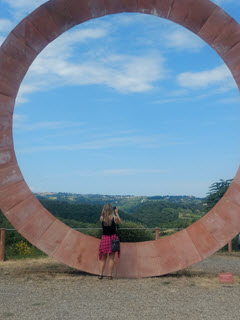 We had a crazy adventure getting out of Florence (a place I hope to never drive in again!) but finally we were out on the open road rolling through the Tuscan hills in our Alfa Romeo.
We had a crazy adventure getting out of Florence (a place I hope to never drive in again!) but finally we were out on the open road rolling through the Tuscan hills in our Alfa Romeo.
Tuscany is famous for wine and meats, of course, but also for terracotta decorative and culinary pottery. We found the former, but Alas! not the latter. Having read about flower-pot chicken and the German romertopf and the Moroccan tagine, I had hoped to score some nice practical Italian version as a souvenir for the kitchen, but the place we visited was garden and architectural pieces and we had no time to seek out another maker.
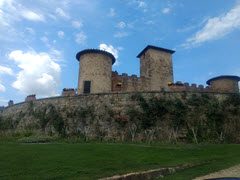
We visited the spectacular Castello Gabbiano winery at the grand old castle on the hill, and enjoyed a tasting. We agreed upon a lesser-known bottle and bought that to enjoy some night in a hotel room. Then we followed the Chianti Wine Trail as far as Greve in Chianti, where the rains overtook us and we broke for lunch.
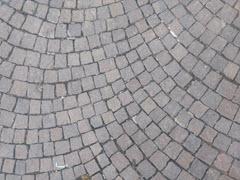
Here's something interesting that I noticed all over Italy: in many, many cities and towns, you see the same black square cobbles in the same burden-sharing curved formation. They're clearly volcanic in origin. I find them attractive, but Italians have diverse opinions on the subject. They certainly add charm, but we learned on this day that they are indeed slippery when wet!
NOTE: We're putting a patio behind our house, so I looked into whether and US paver supply companies have reproduced this black worn cobble look, but I found none.
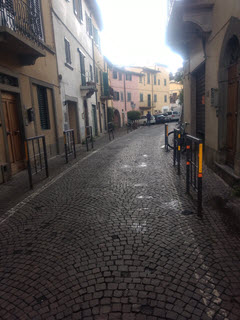 Lunch was at Lepanto in Greve in Chianti. It included local specialty Cinghiale (wild boar) stew, ravioli, fusilli, a Greek salad, and some of the local Chianti, of course. The wine list was longer than the Bible, and we found a Gabbiano that we had sampled at the winery, so we shared that bottle. The lunch was very good, but not the best meal of the day.
Lunch was at Lepanto in Greve in Chianti. It included local specialty Cinghiale (wild boar) stew, ravioli, fusilli, a Greek salad, and some of the local Chianti, of course. The wine list was longer than the Bible, and we found a Gabbiano that we had sampled at the winery, so we shared that bottle. The lunch was very good, but not the best meal of the day.
Greve in Chianti is pretty much the midpoint of the SR222 Chianti Wine Trail. It's a small town with a big piazza, a few narrow one-way roads, and little parking. There's some shopping, but it's not Sonoma or Healdsburg. I might spend a night or two there if I were exploring many wineries, but I didn't see it as a cultural center.
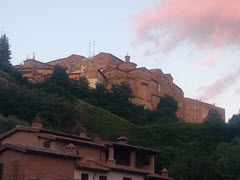
The drive to Siena was a mixed bag of excellent scenery obscured by rain and gray skies. It really is a lovely drive, with lots of up and down, left and right, wide vistas and close-in mountains and flower-covered walls.
We finally reached Siena with a lot of help from Giulia's onboard navigation. We parked at a big lot at the bottom of the hill, and then walked up to the stairway to heaven - a series of escalators, up and up, one after the other, to get up to the center of this ancient hill-city.
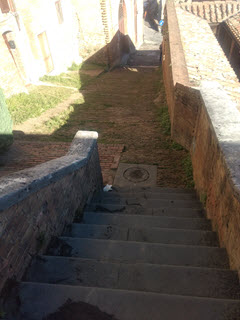
Siena is a very vertical city. Everything is clustered together at the top of the hill, so like Manhattan, they have to build up. The edges of the city cling to the hillside and there are stairs everywhere - they're just a fact of life in Siena. I would expect a cardiologist in Siena to be pretty bored waiting for clients!
When you explore Siena, your legs and your heart get a good workout, and you also work up a heck of an appetite. That's great, because Siena is both a shoppers' paradise and a foodie heaven.
For shopping, there's the usual stunning array of Italian leather goods, clothing, and other stuff that is somewhat lost on me, but the cook can also find wonderful olive wood cutting boards and bowls and utensils, colorful hand-painted pottery, cooking dishes, and fine glassware.
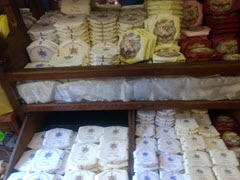
Siena's foodie goodness includes panforte, cinghiale salami and other artisan salumi, cheeses, summer truffles, Ricciarelli cookies, and more. The city is between the Chianti, Montalcino, and Montepulciano wine regions, and there are other, lesser-known varieties in abundance. The celebrated Brunello di Montalcino is on menus everywhere by the glass and by the bottle. And of course there's that Bistecca alla Fiorentina.
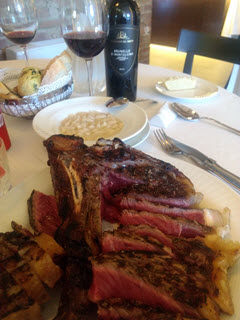
That brings us to the fabulous dinner that we had at Tar-tufo in Siena, for a mere €203 and worth every penny. My Bistecca obsession was starting to interfere with my life. Research over the winter had shown Tar-Tufo to be proud of their authentic Chianina bistecca, so it was a must-visit on this trip. We arrived when they opened for dinner, ahead of the fashionable crowd.
Our dinner comprised:
- An amuse-bouche with a sliver of octopus inside, but they made a mollusc-free version for Melissa and Lorna
- A bottle of Brunello di Montalcino
- A vegetable dish highlighted by asparagus tips, all perfectly cooked
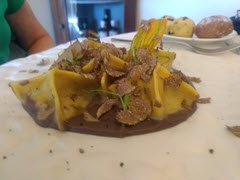 The Bistecca alla Fiorentina: Please read about it at that link to see why all the fuss. The chef carved a steak off of a larger beef, and our server presented it for my approval before committing it to the chef. It was 1.3 kg, not to my order but because that's how big it was when he carved what he could cook. At 5 euro/hectogram, it was 65 euro ($80). It came out perfectly according to all that I had read and expected. The server carved it for me and I was very happy.
The Bistecca alla Fiorentina: Please read about it at that link to see why all the fuss. The chef carved a steak off of a larger beef, and our server presented it for my approval before committing it to the chef. It was 1.3 kg, not to my order but because that's how big it was when he carved what he could cook. At 5 euro/hectogram, it was 65 euro ($80). It came out perfectly according to all that I had read and expected. The server carved it for me and I was very happy. 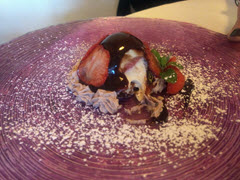 In the meantime, both Lorna and Melissa had a ravioli dish with fresh-shaved black summer truffle (tartufo in Italian)
In the meantime, both Lorna and Melissa had a ravioli dish with fresh-shaved black summer truffle (tartufo in Italian)- A dessert amuse-bouche and then a dessert for the ladies, espresso for me.
After dinner we returned to the car via outside stairways and then drove to Orvieto to stay at the Torre Polidori, but that's tomorrow's story.
